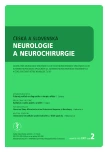Correlation between ptiO2 and Apoptosis in Focal Brain ischaemia and the Influence of Systemic Hypertension
Authors:
F. Otevřel 1; M. Smrčka 2; Š. Kuchtíčková 1; J. Mužík 3
Authors‘ workplace:
Ústav normální a patologické fyziologie LFMU Brno
1; Neurochirurgická klinika FN Brno, pracoviště Bohunice
2; Centrum biostatistiky a analýz LFMU Brno
3
Published in:
Cesk Slov Neurol N 2007; 70/103(2): 168-173
Category:
Original Paper
Overview
Introduction:
Current neurosurgery and intensive medicine often deal with patients threatened by focal brain ischemia. Temporary ischemia has been used purposefully in some neurosurgical interventions. In the centre of ischemia, the tissue is menaced with necrosis but in the surrounding tissue (penumbra) the cells become extinct via apoptosis. Systemic hypertension can delay the extinction of cells by apoptosis in the tissue in the penumbra region probably by means of involving leptomeningeal collaterals.
Material and Methods:
We have used a thread model of focal brain ischemia in a sewer-rat which enables to perform controlled focal ischemia for the selected interval with long-term reperfusion. The effects of systemic hypertension on partial O2 pressure in the penumbral tissue and the number of cells disappearing via apoptosis were studied by means of TUNEL test. The total of 70 sewer-rats were operated on, which had been divided into groups of normotensive and hypertensive animals and then into groups with 15 or 30 minutes of focal ischemia. Reperfusion lasted for 48 hours.
Results:
Significant difference (p < 0.001) was demonstrated between normotensive and hypertensive groups with 15-minutes´ ischemia both in the values of ptiO2 and decrease of the number of TUNEL+ cells, namely in favour of hypertensive rats. The comparison of 15-minutes´ normotensive and 30-minutes´ hypertensive ischemias showed an interesting significant difference in the initial and terminal values of ptiO2 (p < 0.001) in favour of hypertension but the decrease of ptiO2 is not significantly different (p = 0.141). TUNEL+ neurons of the cortex were fewer in number in the hypertensive group (p = 0.005).
Conclusion:
Systemic hypertension delays the extinction of cells via apoptotis in the tissue in the penumbra region. The number of TUNEL+ cells depends rather on the absolute value of ptiO2 than on the size of decrease in values during ischemia. Monitoring ptiO2 in clinical practice can also serve as an indicator of threatening the brain tissue with apoptosis.
Key words:
Brain focal ischemia, reperfusion, tissue oxymetry, apoptosis, sewer-rat, hypertension
Sources
1. Darby JM, Yonas H, Marks EC, Durham S, Snyder RW, Nemoto EM. Acute cerebral blood flow response to dopamine-induced hypertension after subarachniod hemorrhage. J Neurosurg 1994; 80: 857-64.
2. Brown FD, Hanlon K, Mullan S. Treatment of aneurismal hemiplegia with dopamine and manitol. J Neurosurg 1978; 49: 525-9.
3. Wise G, Sutter R, Burkholder J. The treatment of brain ischemia with vasopressor drugs. Stroke 1972; 3: 135-40.
4. Drummond JC, Oh YS, Cole DJ, Shapiro HM. Phenylephrine-induced hypertension reduced ischemia following middle cerebral artery occlusion in rats. Stroke 1989; 20: 1538-44.
5. Cole DJ, Drummond JC, Matsamura JS, Marcantonio S, Chi-Lum BI. Hypervolemic-hemodilution and hypertension during temporary middle cerebral artery occlusion in rats: effect on blood-brain barrier permeability. Can J Neurol Sci 1990; 17: 372-7.
6. Cole DJ, Drummond JC, Ruta TS, Peckham NH. Hemodilution and hypertension affects on cerebral hemorrhage in cerebral ischemia in rats. Stroke 1990; 21: 1333-9.
7. Ogilvy CS, Carter B, Kaplan S, Rich C, Crowell RM. Temporary vessel occlusion for aneurysm surgery: risk factors for stroke in patients protected by induced hypothermia and hypertension and intravenous manitol administration. J Neurosurg 1996; 84(5): 785-91.
8. Smrčka M, Horký M, Otevřel F, Kuchtičková Š, Kotala V, Mužík J. The Onset of Apoptosis of Neurons Induced by Ischemia-Reperfusion Injury Is Delayed by Transient Period of Hypertension in Rats. Phys Res 2003; 52: 117-22.
9. Katzo I. Brain edema following brain ischemia and the influence of the therapy. Br J Anesth 1985; 57: 18-22.
10. Cole DJ, Drummond JC, Osborne TN, Matsamura J. Hypertension and hemodilution during cerebral ischemia reduce brain injury and edema. Am J Physiology 1990; 259: H211-7.
11. Schurer L, Grogaard B, Arfors KE, Gerdin B. Is postischemic hypoperfusion related to brain edema? Adv Neurol 1990; 52: 155-64.
12. Kolář Z. Úvod do molekulární patologie a onkologie. Olomouc: Vydavatelství Palackého univerzity 1997: 48.
13. Rosypal S. Úvod do molekulární biologie. Díl 2. Molekulární biologie eukaryot. 3. ed. Brno: Stanislav Rosypal 1999: 600 s.
14. Smrčka M, Otevřel F, Kuchtíčková Š, Horký M, Juráň V, Duba M et al. Experimental Model of Reversible Focal Ischemia in The Rats. Scripta medica 2001; ročník: 391-8.
15. Horký M, Horský P, Kolář F. Different onset of nucleolar activation in endocardial endothelial cells and cardiomyocytes following presure oveload in rat heart. J Mol Cell Cardiol 1997; 29: 2475-81.
Labels
Paediatric neurology Neurosurgery NeurologyArticle was published in
Czech and Slovak Neurology and Neurosurgery

2007 Issue 2
Most read in this issue
- Epilepsy and the Sleep-Waking Cycle
- The Current View of the Diagnostics and Therapy of Aphasias
- Complications of the Anterior Cervical Spine Surgery for a Degenerative Disease
- Worsening of Epileptic Seizures and Epilepsies due to Antiepileptic Drugs – is it Possible?
